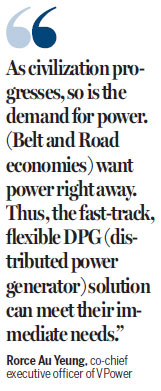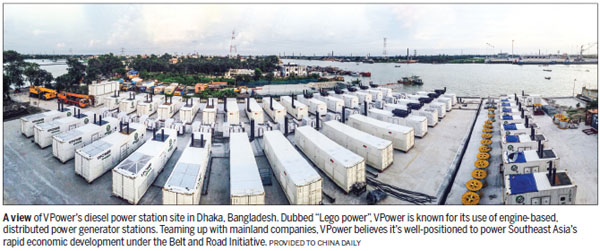Powering growth for the powerless
Updated: 2017-06-30 06:44
By Evelyn Yu in Hong Kong(HK Edition)
|
|||||||||
Energy-starved countries and regions involved in the China-led Belt and Road Initiative (B&R), including many in Southeast Asia, have a lot to be grateful for as the ambitious project revs up.
Powering them for industrilization and lighting them up is big business and, among the first to throw their hats in the ring is Hong Kong-listed VPower Holdings Ltd - a global mover in the provision of power generation solutions for industries.
"Lego power" is VPower's nickname for its use of engine-based, distributed power generator (DPG) stations in the B&R economies.
At one of the company's DPG sites in Myanmar, an array of ISO-standardized containers with modular DPGs lies scattered on the ground. It only takes some four months to build a "Lego" power station, which is mobile and flexible and could be used in a plug-and-play manner. The unconventional power stations offer an ideal solution for power-hungry Southeast Asian nations as they ponder the economic opportunities created by the B&R.
"Most of the countries along the B&R are often plagued by power shortages. Local power bureaus and the authorities are in dire need of large-scale infrastructural power stations but, with shoestring budgets, this would take years," said Rorce Au Yeung, co-chief executive officer of VPower.
"But, as civilization progresses, so is the demand for power. They want power right away. Thus, the fast-track, flexible DPG solution can meet their immediate needs," he said.

VPower had made its presence felt in Southeast Asia before the B&R Initiative came on. Currently, it has eight projects in the B&R markets, providing more than 20 percent of Myanmar's DPG power supply and has become Southeast Asia's largest private gas-fired, engine-based DPG station owner and operator over the years.
VPower went public on the main board of the Hong Kong stock exchange late last year. The company posted a net profit of HK$222 million for the year ended Dec 31, 2016 - up nearly 58 percent over the previous year's.
According to Au Yeung, DPG operations account for just 8 to 9 percent of the global power market, with primary power supply still coming from conventional, centralized power stations.
But, the DPG method holds great promise and fits in well with Southeast Asian countries.
"Many Southeast Asian nations don't have a national grid and, even if they have, it's very old. In Myanmar, 25 percent of the electricity generated is lost during transmission. The electrification rate is below 30 percent, which means over two-thirds of the people don't have access to electricity. Even in Indonesia - the region's biggest economy - about 20 percent of the people have no power supply," said Au Yeung.
Many Southeast Asian countries, although rich in natural resources, are grappling with acute power shortages due to poor transmission and distribution infrastructure. For instance, in the Philippines - an archipelago of more than 7,000 islands - many of the remote locations have yet to be connected to a grid.
The Asian Development Bank says hydropower contributes 62 percent to Myanmar's power supply, but the capacity drops sharply during the dry season, leading to long and frequent power cuts.
Au Yeung is sanguine about the business prospects generated by the B&R Initiative.
"Funding can come from the AIIB (Asian Infrastructure Investment Bank) and the Silk Road Fund, while Singapore is coming up with its own B&R Initiative fund, most of which are US-dollar funds. Investors would like to use these funds and start their projects immediately. The first thing you need is power and these funds will bring us lots of opportunities," he said.
To date, VPower has yet to engage in projects financed by the above-mentioned B&R funds, said Au Yeung, but it has been pre-positioning itself for the upcoming opportunities.
The Myanmar crude pipeline is part of the B&R project, allowing the Chinese mainland to import crude from the Middle East and Africa without having to ship through the Straits of Malacca or the South China Sea. Xinhua News Agency said the 771-kilometer pipeline is designed to carry 22 million tons of crude a year and Myanmar can take 2 million tons annually.
China National Petroleum Corporation - China's largest State-owned integrated energy enterprise - began importing gas from Myanmar in 2013 through another pipeline.
Au Yeung revealed that, based on what he had gathered at B&R conferences and forums so far, the mainland plans to return millions of tons of gas to Myanmar through the pipeline.
VPower works with local governments using the Investment, Building and Operating model, in which the local government would provide the fuels and build the DPG stations.
Au Yeung said it's logical for the Myanmar government to expand its power supply market, most probably, during the coming dry season. His team in Rangoon is actively collecting market intelligence and will be ready to respond quickly to any public tendering for new projects.
The company signed a memorandum of understanding with Citic Pacific - the overseas arm of mainland conglomerate Citic Group - in March this year in a bid to co-invest in a gas-fired power station in Southeast Asia through joint ventures. Citic Pacific is the cornerstone shareholder of VPower.
Au Yeung said the company's strategic alliance with Citic Group and State-owned railcar giant CRRC Corporation, which also participates in the B&R Initiative, will have it well-placed to power Southeast Asia's rapid economic development.
evelyn@chinadailyhk.com

(HK Edition 06/30/2017 page6)